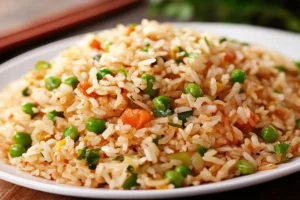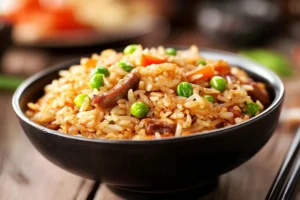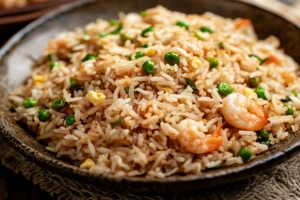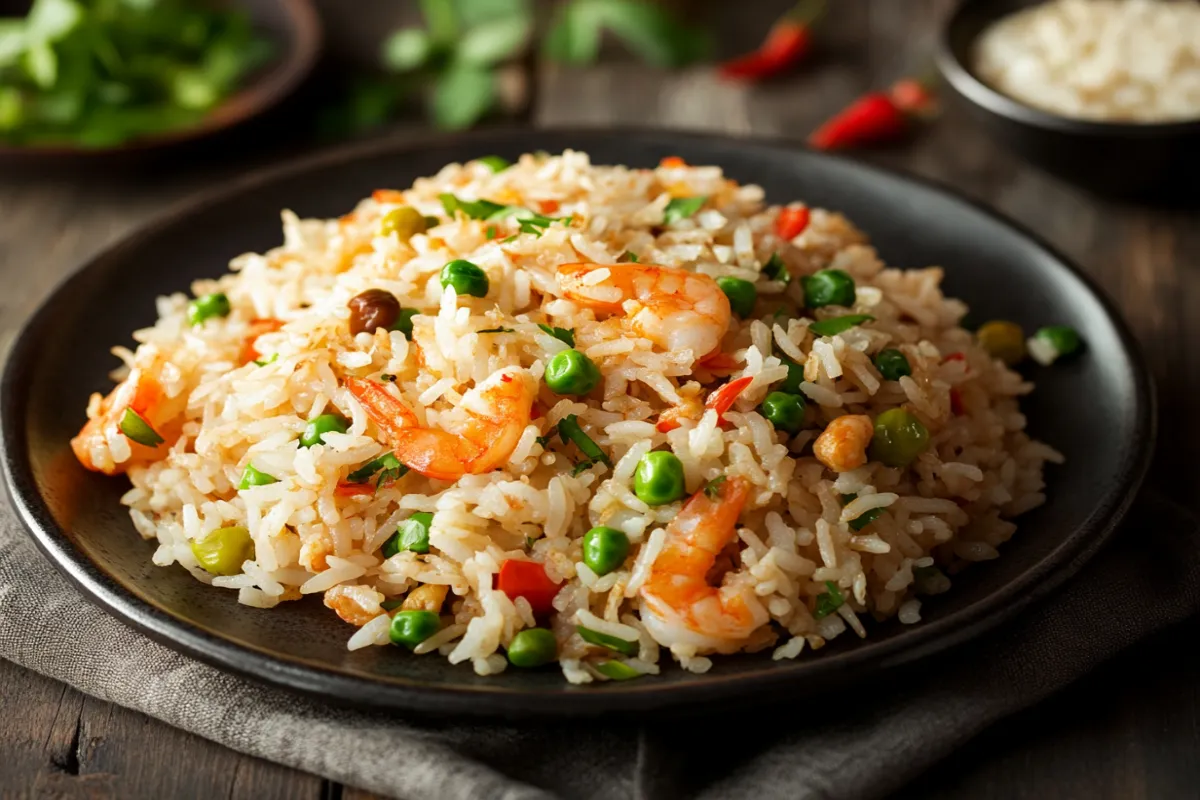How Do Chinese Restaurants Make Fried Rice Taste So Good?
If you’ve ever tried making fried rice at home and wondered why it doesn’t taste quite like the delicious version you get from Chinese restaurants, you’re not alone. Chinese restaurant fried rice is famous for its flavor, texture, and aroma. The question is: how do they do it? This article will dive deep into the techniques, ingredients, and secrets that make restaurant-style fried rice so good, and we’ll even show you how to replicate it at home.
Why Fried Rice Is a Staple in Chinese Cuisine
Fried rice is a quintessential part of Chinese cuisine that originated as a way to use up leftover rice and transform it into a new dish. Over the centuries, the dish has evolved into a versatile and beloved meal, with regional variations such as Yangzhou fried rice and Cantonese fried rice. While the ingredients may vary, the core techniques and flavors remain consistent.
The magic of fried rice lies in its umami-rich flavor, a balance of salty, savory, and sometimes slightly sweet notes. Chinese restaurants achieve this with specific ingredients, cooking methods, and equipment. Understanding these elements is key to making perfect fried rice at home. For more insights into the role of umami, check out this guide on the secrets of fried rice.
The Right Rice Makes All the Difference

One of the most crucial aspects of making great fried rice is choosing the right type of rice. Chinese restaurants typically use long-grain or medium-grain rice, which offers a firmer texture that holds up better when stir-fried. Additionally, day-old rice is preferred because it’s slightly dried out, making it less sticky and easier to fry without clumping. Freshly cooked rice, on the other hand, is too moist and can turn mushy when stir-fried.
Using rice that’s been cooked and stored overnight in the fridge helps it firm up and develop the perfect texture for fried rice. Restaurants rely on this technique to ensure their fried rice is light, fluffy, and free from excess moisture. For a detailed explanation of the role of day-old rice, visit this guide on wok techniques in fried rice.
Prepping the Rice
When preparing rice for fried rice, it’s important to:
- Rinse the rice thoroughly before cooking to remove excess starch.
- Use slightly less water than usual when cooking the rice, as this makes it firmer and less sticky.
- Let the rice cool completely before frying, preferably refrigerating it overnight.
The Power of the Wok and High Heat
One of the primary tools in a Chinese restaurant kitchen is the wok. This versatile cooking pan allows food to be cooked quickly and evenly over high heat. The shape of the wok makes it ideal for tossing and stirring the ingredients, ensuring that every grain of rice is coated in flavor without burning.
The key to replicating restaurant-style fried rice at home is using a very hot wok and cooking on high heat. This quick cooking method helps develop a slightly charred, smoky flavor known as wok hei, which is essential for authentic fried rice. Wok hei is difficult to achieve on a standard stovetop, but using the highest heat setting and working in small batches can help you get closer to that restaurant flavor.
Can You Make Fried Rice Without a Wok?
If you don’t have a wok, you can still make delicious fried rice using a large skillet or sauté pan. Just make sure to preheat the pan until it’s very hot before adding the rice, and avoid overcrowding the pan to prevent steaming the rice instead of frying it.
Key Ingredients That Enhance Flavor
1. Soy Sauce
Soy sauce is a foundational ingredient in fried rice. It provides the salty, savory base that enhances the umami flavors of the dish. Chinese restaurants often use a combination of light soy sauce for flavor and dark soy sauce for color. Dark soy sauce is richer and slightly sweeter, giving the rice its characteristic brown color without overpowering the dish.
2. Oyster Sauce
Another essential ingredient is oyster sauce, which adds depth and a touch of sweetness to the fried rice. Oyster sauce is made from oyster extracts, giving it a rich, savory flavor with a hint of brininess. It’s a go-to ingredient for many Chinese chefs when making fried rice because it enhances the overall complexity of the dish.
3. Sesame Oil
For an aromatic finish, many chefs add a drizzle of sesame oil toward the end of cooking. Sesame oil has a strong, nutty flavor that can overpower the dish if used too early, so it’s typically added right before serving to infuse the fried rice with a fragrant, roasted aroma.
4. MSG (Monosodium Glutamate)
While not everyone uses it, MSG is a common flavor enhancer in many restaurants. It amplifies the umami flavor, giving the rice a savory depth that’s hard to replicate without it. If you’re comfortable using MSG, a small amount can make a noticeable difference in the taste of your fried rice.
5. Lard or Bacon Fat
Surprisingly, some Chinese restaurants use lard or bacon fat to fry their rice. These fats give the dish a richer, more indulgent flavor. Using bacon fat, in particular, adds a subtle smokiness that complements the other flavors perfectly. Try adding a spoonful of bacon fat or lard when cooking your next batch of fried rice for an extra burst of flavor.
Cooking Techniques for Perfect Fried Rice

Chinese restaurant chefs are masters of technique, and when it comes to fried rice, technique is just as important as ingredients. Here are the key steps to achieving perfect restaurant-style fried rice:
1. Cook in Batches
One of the most common mistakes home cooks make is overcrowding the pan. When you add too much rice to the pan at once, it steams instead of fries. This leads to soggy, clumpy rice rather than the dry, separated grains found in restaurant fried rice. Always cook in batches to allow the rice to fry evenly.
2. Use High Heat
Cooking on high heat is essential for developing the right texture and flavor. High heat allows the rice to fry quickly, which prevents it from becoming mushy. It also helps create a light char on the rice, adding that distinct, smoky flavor that’s so characteristic of restaurant fried rice.
3. Toss the Rice Frequently
Constantly tossing or stirring the rice helps to evenly distribute the heat and ensures that every grain is coated in flavor. It also prevents the rice from sticking to the bottom of the pan.
4. Cook the Proteins and Vegetables Separately
Many Chinese chefs cook the proteins and vegetables separately from the rice to maintain their texture and flavor. Once they’re cooked through, they’re added to the rice for a final stir-fry. This method ensures that the meat stays juicy and the vegetables remain crisp.
Customizing Fried Rice: Proteins and Vegetables
One of the great things about fried rice is its versatility. You can customize it with your favorite proteins and vegetables to suit your taste. Here are some popular options:
- Proteins: Shrimp, chicken, pork, beef, or tofu are commonly used in fried rice. Marinate the protein before cooking to infuse it with flavor.
- Vegetables: Peas, carrots, onions, scallions, and bell peppers are classic choices. Add them toward the end of cooking to retain their color and crunch.
When to Add Each Ingredient
Timing is crucial when making fried rice. Proteins like shrimp and chicken should be cooked at the beginning, while vegetables like peas and carrots should be added toward the end to prevent overcooking. This ensures that each ingredient retains its texture and contributes to the overall flavor of the dish.
Why Cooking in Bulk Enhances Flavor
Restaurants often cook fried rice in large batches, and this bulk cooking contributes to the dish’s flavor. When food is cooked in larger quantities, it retains more heat, allowing for better caramelization and browning. This process enhances the umami flavors and gives the rice a richer, more robust taste.
At home, you can replicate this by cooking the rice in small batches while making sure to maintain high heat. This prevents the rice from steaming and ensures it fries properly, giving you that sought-after restaurant-quality taste.
Umami: The Secret Flavor in Fried Rice
The key to why Chinese restaurant fried rice tastes so good is the presence of umami, the savory flavor that makes dishes rich and satisfying. Umami is found in ingredients like soy sauce, oyster sauce, and MSG, which work together to create a deep, layered flavor.
Balancing the umami with salty, sweet, and slightly sour elements is what gives fried rice its signature taste. Without this balance, the dish would be one-dimensional and less flavorful.
Frequently Asked Questions
Why Does Chinese Restaurant Fried Rice Taste Different Than Homemade?
Restaurant fried rice benefits from high heat, the use of a wok, and specific sauces like soy sauce and oyster sauce that may not be used in homemade versions. The wok hei flavor and precise cooking techniques also contribute to the superior taste.
Can I Make Fried Rice Without a Wok?
Yes, you can make fried rice without a wok by using a large skillet or sauté pan. The key is to use high heat and cook the rice in small batches to achieve the right texture.
What Kind of Rice Is Best for Fried Rice?
Long-grain or medium-grain rice is best for fried rice because it has less starch, which helps prevent clumping. Always use day-old rice to achieve the ideal texture.
How Can I Get My Fried Rice to Be Less Soggy?
To avoid soggy fried rice, make sure to use day-old rice, cook in small batches, and avoid adding too much liquid. Cooking over high heat also helps dry out the rice and create a light, fluffy texture.

Conclusion: Bringing Restaurant-Quality Fried Rice to Your Kitchen
Making restaurant-quality fried rice at home is entirely possible with the right techniques and ingredients. By using day-old rice, cooking with high heat, and incorporating key ingredients like soy sauce, oyster sauce, and sesame oil, you can achieve the same delicious flavors found in Chinese restaurants. Remember, practice makes perfect—experiment with different ingredients and techniques to find the perfect balance for your taste.

